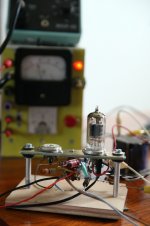Hi all,
I'm trying to find out what the triode section of an ECF80 (PCF80 in my case) can be compared to, but it's a little over my head. I'm thinking (hoping) that it's like ECC81, but I'm not sure. Searching didn't help, can someone here shed some light on it? Thanks in advance!
I'm trying to find out what the triode section of an ECF80 (PCF80 in my case) can be compared to, but it's a little over my head. I'm thinking (hoping) that it's like ECC81, but I'm not sure. Searching didn't help, can someone here shed some light on it? Thanks in advance!
Mu is 20, slightly higher than ECC81. Transconductance is double, so it's similar to both sections of 12AU7/ECC81 in parallel. Linearity is likely not great, as it's designed as an oscillator, but that's of little impact when used as split-load phase inverter.
Thanks!
ECC81 mu = 70.. But yeah, ECF80's triode mu = 20
I have been looking a lot at PCF802 (until I saw that both cathodes are connected, can't use that) that confused me. Afaik there are no 'modern' small signal triodes with a mu as low as 20. We're getting somewhere.
ECC81 mu = 70.. But yeah, ECF80's triode mu = 20
I have been looking a lot at PCF802 (until I saw that both cathodes are connected, can't use that) that confused me. Afaik there are no 'modern' small signal triodes with a mu as low as 20. We're getting somewhere.
ECC81 = 12AT7. ECC82 = 12AU7. ECC83 = 12AX7.
12AT7 μ = 60. 12AU7 μ = 20. 12AX7 μ = 100. Don't forget the very important impact of RP on gain.
12AT7 μ = 60. 12AU7 μ = 20. 12AX7 μ = 100. Don't forget the very important impact of RP on gain.
Oops! was thinking of ECC82. Like using the metric system - I worked with metric dimensions / hardware for years, still don't THINK in metric.
Afaik there are no 'modern' small signal triodes with a mu as low as 20.
JJ's comparatively recent ECC99 has a μ of 22.
JJ's comparatively recent ECC99 has a μ of 22.
But that's more like a power tube 😀 I was talking rubbish anyway, how could I forget 6SN7?
6SN7 has half the transconductance. So as Tom Bavis said it's like two ECC82/12AU7/6SN7/6CG7 triodes in parallel.
No. PCF80 and PCF802 share exactly the same pinout. PCF82 also does. Both cathodes are well separated. Maybe the cause is that the 802 was the 80's successor as a line oscillator/reactance tube.I have been looking a lot at PCF802 (until I saw that both cathodes are connected, can't use that) that confused me.
The 802's triode is high µ, though, resembling half of a 6SL7.
Best regards!
<snip>I have been looking a lot at PCF802 (until I saw that both cathodes are connected, can't use that) that confused me.</snip>
That is incorrect. Triode cathode is pin 8, Pentode cathode is pin 7.
For our American friends, ECF802 is supposedly equivalent to 6JW8 and the base is 9DC.
PCF801/8JG7 has the cathodes joined.
Look at ECC804, also known as 6/30L2. This may be sold by some people as 'Mazda 6CG7', although it is not a 6CG7.
Look at ECC804, also known as 6/30L2. This may be sold by some people as 'Mazda 6CG7', although it is not a 6CG7.
PCF801/8JG7 has the cathodes joined.
...dito PCF86 and most probably many more...
Best regards!
That is incorrect. Triode cathode is pin 8, Pentode cathode is pin 7.
You're right. Now I don't know why I thought that.. 🙄
- Home
- Amplifiers
- Tubes / Valves
- ecf80 triode section equivalent
